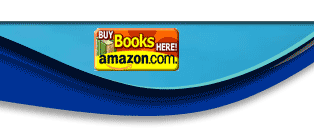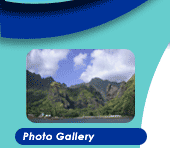March
2, 2001
Puerto
Aguadulce, Panama
Pacific Bliss Goes up the Creek
By Lois and Gunter  
Pacific Bliss is six miles up the river Estero Pablo Blanco tied to
massive pilings on private property owned by a cane sugar factory.
Every six hours, we are at high tide or low tide. At 2:45 AM this
morning, Pacific Bliss saw only 5’6” of water beneath her hulls; at
2:45 PM this afternoon, her depth meter showed over 16’. When
the water is low, the view from our master cabin window is of river
bottom, rocks, and the bottom of the pilings.
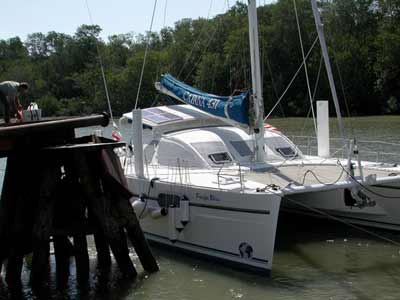
Pacific Bliss up the Creek.
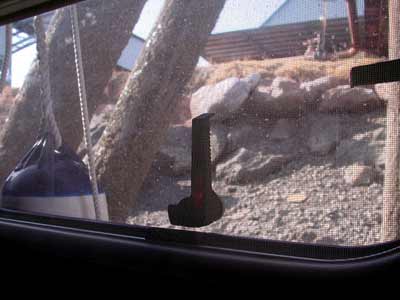
Photo: View from Window at Low Tide.
Most of the books and stories one reads about cruising are about couples
or families. We have now become one of those cruising couples.
Our last crew, Phyllis and Richard Schwartz, left for San Jose, Costa
Rica and then Yucca Valley, California on February 20th, the day after
we transited the Canal, sporting clean travel clothes, and hopefully,
none the worse for all the adventures they endured. Now, we are
taking our time cruising Panama’sPacificCoast on our way to Golfito,
Costa Rica.
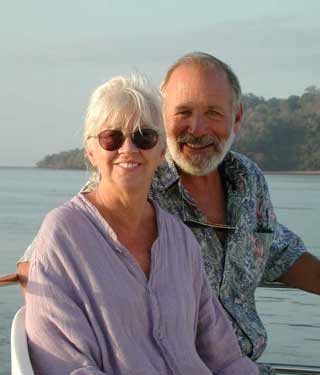
Phyllis and Richard, Ready to Say
Farewell.
We decided to make dayhops, with one overnight sail coming into Banana
Bay Marina in Golfito. We left on the morning of February 28th
for the first dayhop, 28 miles to the Bahia de Chame. As we pulled
into the channel to exit Balboa, we met the Colombian tall ship Gloria
in full regalia, motoring toward the Canal. At first, we thought
that she was was flying banners from her many spreaders, but as she
came closer, we realized that the crew was standing on the spreaders,
all the way to the top! In fact, crew was even balanced
on the bowsprit. What a breathtaking sight!
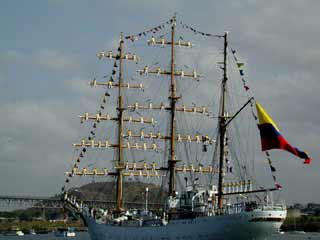
Colombian Tall Ship, Gloria.
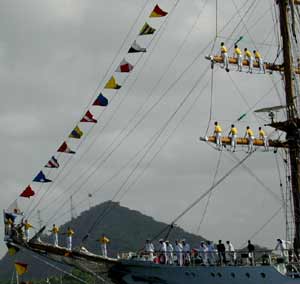
Close-up of Crew and Officers
We passed an “explosives” anchorage, in which over 25 freighters were
anchored, waiting to transit the Canal. It is understandable that
the Canal authorities do not like to “mess with” small sailing vessels;
they pay $500 to transit the Canal (although this fee will increase
to $1350) and are a hassle, whereas the Canal can make $100,000 from
one freighter.
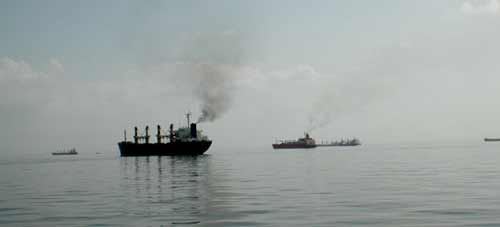
Freighters Waiting in the Explosives
Anchorage
The day was sunny, with the typical Panamanian haze. In a NE
wind of only 6-7 knots, we motored to our anchorage. We
passed Isla Taboga, called the “FlowerIsland” a common resort getaway
for Panamanians since the late 1880s, during the aborted French attempt
to build the Canal. Convalescents from yellow fever and malaria
were sent there to recuperate in the “better air.” At that time
it was thought that turning over so much dirt stirred up the “bad vapors”
and that fresh air and clean surroundings was the answer. They
had no idea that certain mosquitoes were carriers of both diseases.
The island has no cars. A 1½ -hour ferry ride takes tourists to
and fro. Flocks of pelicans and a few snowy-white great egrets
flew over Pacific Bliss as she passed the island on her port.
Our peaceful day was interrupted by a rather white-knuckled approach
into the anchorage. Approaching conical-shaped Pan de Azucar
and Isla Ensenada, the passage is was only five feet at low tide, which
occurred within ½ hour of our entrance there. Then the depth increased
to 20 feet as we approached the anchorage given in the Panama Cruising
Guide. It took several tries to set the anchor in
the lee of the convex-shaped Isla Ensenada, our bow facing the island.
The NE wind we had when anchoring changed to N before we retired for
the evening, and by 2300 had changed to NW at 20 knots! Our stern
now faced the island, and although we could see that the shore was sandy,
we slept uneasily, fearing that the anchor would twist with the changing
wind and break loose. We used our new GPS/anchor alarm purchased
in Panama City for the first time.
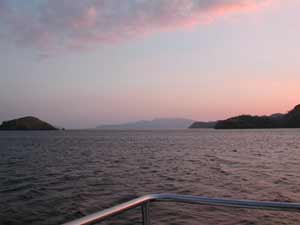
Leaving our Anchorage at Isla Ensenada.
The next day, we left at dawn to seek a more protected anchorage, Puerto
Aguadulce, over 75 miles away. We were ready for a good night’s
sleep! We experienced variable winds along the coast, ranging
from NNW F4-F5, to N F5, NNE F4, motorsailing, then back to F1, where
we took down the sails completely on a glassy sea. Lois
wrote in the logbook, F1: What an insult! That was a mistake.
Ten minutes later, the wind changed back to the North, increasing from
F4 to F6, then gusting to F7 at 33 knots, whitecaps breaking on the
bay as we entered the estuary (Estaro Pablo Blanco) leading to the river.
We snaked through the buoys guiding us into the main channel.
Then we wound slowly through the narrow river channel (this time with
a rising tide) at depths averaging about 14 feet.
Six miles up the river, we passed the huge and seemingly out-of-place
commercial dock of Puerto Aquadulce. A freighter, surprisingly,
was tied up to the high mole. The Guide advised us to anchor around
the first bend in the river, supposedly only 10 feet at low tides.
As we diligently rounded the bend, the river increased in depth to 24
feet! It supposedly narrowed to almost nothing around the bend
after that, so tried to anchor there in water that was shallower, but
the current was too strong. After two attempts, with the current
flowing Up the Creek, due to the incoming tide, some men on shore motioned
us to go back to the commercial area.
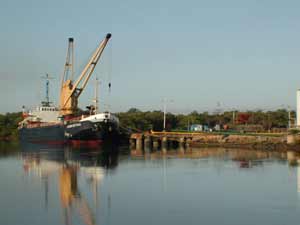
Puerto Aguadulce at Dusk
“Donde?” Gunter yelled.
“Ahi” we thought we heard them reply.
The men ran in and out of the mangroves lining the shore as we
slowly proceeded back down the river. Then they motioned us to
a rusted platform on top of one of three sets of huge log pilings.
“Aqui?” Lois asked from the bow of Pacific Bliss, frowning at the scene
and imagining our beautiful new CAT scratched against the wood and rusty
metal. But we had wanted to sleep quietly, and the staying in
the middle of the river seemed out of the question.
Gunter, at the helm, commanded, “Get out all the fenders. We
have and put them on the starboard, quickly.”
Lois never tied on fenders so fast. Then he said, “And get the
dock lines ready to throw.”
“Captain,” Lois yelled from the bow, “If you will recall, you are down
to one crew.”
“You’re not crew,” Gunter called out. “You’re my partner.”
Relieved, Lois said, “Well, then, I advise you to go back out into
the river to give me some time to set up.”
Gunter turned Pacific Bliss back into the river; we prepared the dock
lines, then we closed in again on the pilings. Lois had to throw
the lines, one by one, upwards to the platform. Two dock lines
were tied together to make bow and stern lines to tie to the other pilings.
A spring line was tied to the platform, allowing sufficient slack for
tide differentials. These guys—about five of them were there now
helping, along with six observers--knew what they were doing.
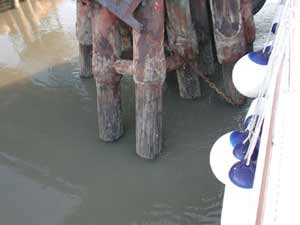
Pacific Bliss Tied to the Pilings
Gunter asked them about the tide swings here. The conversation
was completely in Spanish. He thought they said, “five feet.”
In the middle of the night, we knew better. Lois woke at 0200
and peered out of the starboard hull window. She was amazed.
The platform was high above us and we were at the depths of the muddy
river. They meant that the depth of the river would go down to
five feet. The tide swings here are actually about twelve feet!

View from window at low tide.
The next day, now back up to the platform on top of the pilings with
high tide, Baliera, a worker at the factory, offered to take us into
the town of Aguadulce to obtain supplies. We accepted hurriedly,
hoping lower our supplies and ourselves before we again reached low
tide!
The town is quite prosperous. In addition to the little port
that has its ship terminal (they were unloading tall electrical poles
the day we were there) and sugar cane factory, there are polymer and
fertilizer factories, and a well-developed (and clean) commercial district.
Baliera took us to the food market, produce market, bakery, and ice
store. YES! Ice, and for only 25 cents a bag! It all
melted after a few days because we use our freezer as a 2nd fridge to
conserve power, but what a treat. Three workers pulled the spring
lines pulling Pacific Bliss closer to the platform so that we could
lower the groceries down. What friendly, helpful men! They said
that they only get about one yacht per year in Aguadulce. In fact,
the port captain, used to commercial vessels, did not know what to charge
us. He decided on $12 for our two-night stay.
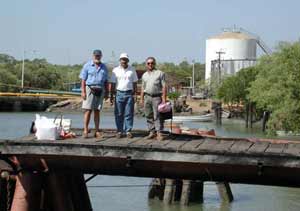
Gunter, Rueben and Baliera with the
supplies.
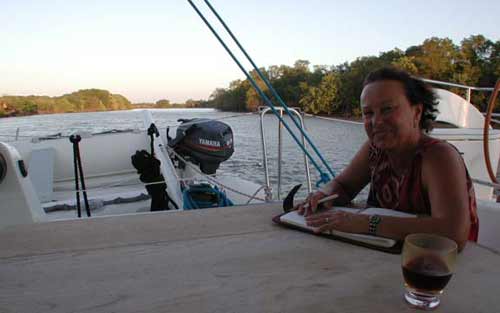
Our new river home: Lois writes in
her journal at dusk.
In the darkness of the night at the bottom of the river, we asked ourselves,
“What are we doing here?” When we flushed the seawater head at
low tide, mucky river water came back in. The mosquitoes invaded
us at dawn and dust, necessitating closing the boat and using fans to
circulate the hot, humid air.
Early this morning, having spent two days and two nights now descending
to the river bottom and rising to the top, we knew the answer.
The friendly workers at the sugar cane factory were there bright and
early at 0615, as promised, to cast us off. The river was glowing,
smooth in the pre-dawn stillness. As we wound our way around the
bends, birds swooped and chirped. The sun peeked over the river
banks, then exploded in a glorious globe of gold. We met fishermen
already out in their canoes, paddling silently. It
was a wonderful morning to be departing from yet another adventure.
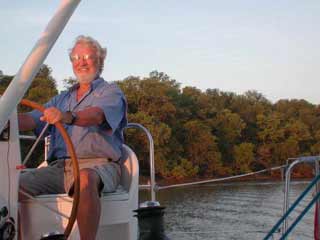
The morning sun shines on Gunter
as we leave Aguadulce.
|




